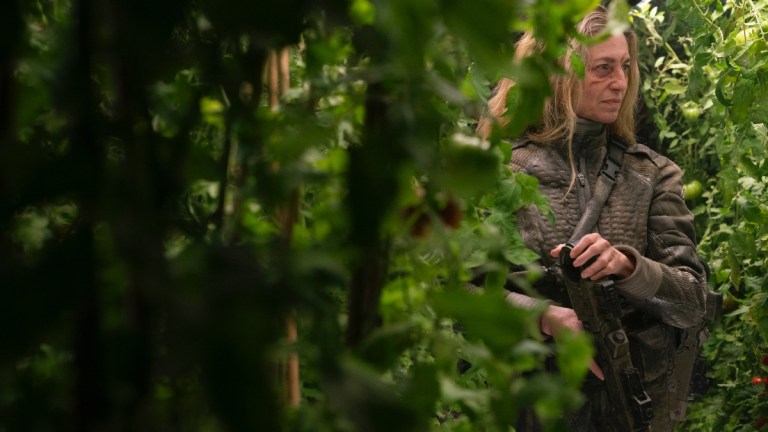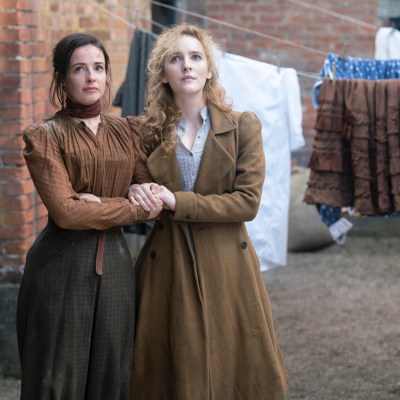The Nevers Part 1 Finale Is The Most Surprising Hour of TV in a Long Time
The Nevers Part 1 conclusion reveals that the show has been a lot more than merely “Victorian X-Men” all along. Let’s examine how.

This article contains major spoilers for The Nevers episode 6.
So that was something, huh? To those who have not yet seen The Nevers episode 6 “True” yet, the above headline may seem fairly overwrought. Really? The most surprising? Wasn’t the Invincible finale just like two weeks ago? To those who have seen the episode in question, however, that designation probably rings true.
How else are we supposed to describe an hour that begins, not in 19th century Victorian era London like the show’s first five episodes, but rather in a far flung future in which 5 billion people are dead and Earth’s atmosphere is toxic? There may have been more surprising twists in TV’s recent past, but it’s hard to recall a recent episode that upends a show’s central premise so extremely, so relatively late into its run. And thanks to the coronavirus pandemic interrupting the show’s production, The Nevers won’t even be able to continue to pursue this rich dramatic vein until “Part 2” of the show’s first season arrives at a still-undetermined later date.
As conceived by prolific TV creator Joss Whedon (before he left the project perhaps in part for also being a prolific jerk), The Nevers first presented itself as a fairly standard superhero tale. It is set in the Victorian era and features a pretty direct allegory: as culture goes through distinct changes, so too do many Victorian women, gaining supernatural powers and banding together as the “Touched.”
That was all fine and dandy but this sixth installment, written by Jane Espenson, really levels up the show’s potential in a profound way. The Nevers isn’t just a show about change, it’s a show about failure to change. Humanity’s petty squabbles over millennia eventually lead to a world in which our only hope of survival is through inter-dimensional travelers known as the Galanthi. But ever the difficult species, many humans turn up their noses at the notion of divine intervention. Now humanity’s last chance lies in the distant past, surrounded by smog, damp umbrellas, and corsets.
This is, to say the least, a lot to unpack. Thankfully, we’ve gone ahead and done all the unpacking for you. What follows are some major questions raised by “True” along with our answers, some of which have been supplemented by the show’s star, Laura Donnelly. You can find that entire interview over here.
For now, however, let’s get started with the obvious…
Wait…what? What was that?
I know, right?
No, seriously. Like…what just happened? Give me a TL;DR
The Nevers’ sixth episode answers a lot of questions and raises even more. We will go in-depth on all of those questions in a moment, but to break it down into only a couple of paragraphs:
It turns out that The Nevers takes place in a (hopefully) distant apocalyptic future in which the Earth is ravaged and the majority of the human population has perished. Suddenly a dinosaur-like alien species known as The Galanthi appear from portals and deposit spores that “improve” some people, giving them a stronger sense of selflessness and all around good vibes. The Galanthi also assist scientists in big projects like water purification and renewable energy. In response to the Galanthi’s arrival, the remnants of humanity split off into two factions: the Planetary Defense Council (PDC), which believes the Galanthi are helping; and Free Life, which are skeptical of them.
As this episode picks up, a woman known by only her military rank “Stripe” is involved with a PDC team to make contact with the last Galanthi. Unbeknownst to Stripe and the team, the Galanthi and his scientist friends have hatched a plot to go back to the late 19th century to give humanity a fresh start and a chance to avoid their catastrophic future. After committing suicide, Stripe finds herself in the body of Victorian England breadmaker Amalia True, who had just made her own suicide attempt (possibly succeeding as well). Cue: episodes one through five of The Nevers.
If that brief description is still a bit too complicated, Donnelly provided Den of Geek with an even more economical run down:
“I think the important information is crystal clear, which is essentially: the Galanthi is an alien race that is here to help humanity from itself, and that Stripe is Amalia.”
Now onto the other lingering questions.
When does The Nevers take place and what happened to Earth?
The show takes place in an unspecified future…at least until Stripe is sent back in time to inhabit Amalia True’s body in the Victorian era. As for what happened to Earth, the simplest answer is probably “humans.” It would appear that all of our centuries of selfish nonsense has rendered the third rock from the Sun a shell of its former self. The air is unbreathable and unable to accommodate pretty much any life. Stripe shocks her crew by taking her oxygen-rich helmet off while in battle. Stripe is also later stunned to see actual organic fruit in the lab.
What are the Galanthi?
The Galanthi are intergalactic and possibly inter-dimensional helpers. No one knows why they first emerged from their portals to assist humanity on Earth but it is fairly clear that they’re here to help…even if Free Life would beg to differ. Their appearance seems to be that of classic scaly monsters. The only time we get to see one is in a video that the scientists recorded. That Galanthi is quadrupedal and about three times the size of a human being. It has Cthulhu-like tentacles on its face. The scientist cheerfully notes that he wasn’t expecting the beast to be this playful, as it nudges him with its head like a cat.
According to Stripe and Knitter, at one point there were around 20 Galanthi but Free Life has been bombing their facilities. As far as anyone knows there is only one Galanthi left on Earth and it’s the one inhabiting this facility. This poor Galanthi is traumatized, however, as Free Life tortured all of its scientist buddies to take away its hope. Now it spends its days in a windowed room in the ceiling, mourning its loss.
What are Free Life and the Planetary Defense Council (PDC)?
The Planetary Defense Council (PDC) is the organization that believes in the mission of the Galanthi. Stripe’s team is made up of PDC personnel and they’re tracking a spatial anomaly to find and defend a Galanthi. Free Life, on the other hand, does whatever it can to make the Galanthi go away. Free Life also doesn’t believe in some of the customs that the PDC has adopted, like concealing one’s own name as sacred. The Free Life representative in this episode’s Chapter One is delighted to tell people his name.
It’s unknown how many people are involved in each faction, but it would seem that Free Life has the upper hand. There is potentially only one Galanthi left. As Stripe eventually explains to her new friend Knitter (Ellora Torchia), the side that banks on hope rather than fear is at an inherent disadvantage. A sizable percentage of the PDC aren’t even true believers in the Galanthi. They are scared of them but believe they are a necessary evil for humanity’s survival. We see how tenuous even the “believers’” belief in the Galanthi is when one of the PDC team betrays his crew.
What was with those Victorian artifacts in the lab?
Somewhat surprisingly (to me at least), this one has an answer already! Thanks to Donnelly, we now know that the scientists were plotting with the Galanthi to send humanity back to one specific timeframe to make things better. The Victorian artifacts were a part of that research. Donnelly explains:
“You realize that the reason that they had an exit portal was because they had a plan for that, that they weren’t coming back. Obviously you see that with the Victorian artifacts in the room. In fact, this plan was brought together with the scientists. They were working on that together.”
The Galanthi was going to exit through its portal, but it wasn’t abandoning humanity – just getting primed to enter into the next stage of its plan in Victorian England.
Who is Stripe?
Stripe is our hero. Played in the first chapter by Claudia Black, Stripe is so called because names are sacred and cannot be revealed. Instead she goes by her military rank.
“At one point they say something about declaring colors and they kind of all go through what the different names are for the different ranks. She’s a Stripe, which is not very high up,” Donnelly says.
As evidenced by her morphine addiction and cynical attitude, Stripe is not necessarily the consummate soldier.
“She’s been kept to a certain level,” Donnelly adds. “And I think that’s down to the fact that she has very strong PTSD and there’s just a lot about her personality that has kind of kept her slightly higher than a foot soldier. She’s not in any level of authority.”
All we know for sure about Stripe is that she hails from southwest Canada (which is fitting, given that the show films in Vancouver) and that her real name is Zephyr Alexis Navine. There is surely more backstory to come eventually and we get to see glimpses of her military past when she interacts with the Galanthi at episode’s end.
The person that we know as Amalia True this entire time has been Stripe inhabiting her body.
Did Stripe Commit Suicide?
Perhaps this was fairly clear but in case you had the same confusion this writer did upon first watch let’s make it clearer. Yes, Stripe did commit suicide. Stripe, Knitter, and the rest of the team truly believed that the last Galanthi was exiting the world for good via its portal. Stripe was already a cynic, but she couldn’t handle taking Knitter’s last bit of hope away from her before she was killed.
As such, Stripe drank a lethal liquid that the PDC seemingly designed for just such a situation and she perished. The last Galanthi wouldn’t let her be dead for long though as it seemingly snatched her soul out of its body and sent it back to Victorian England.
Who Is Amalia True?
Amalia “Molly” True is an actual Victorian lady, but not a Victorian Lady, if that makes sense. Poor Molly (maiden name not given) is a passionate and talented baker. Unfortunately, the only role for her in this society is that of a wife. Even more unfortunately, the man she is pressured to marry, Thomas True, is a world-class asshole.
Thomas belittles Molly’s baking talents and even cruelly makes fun of her two miscarriages. Molly reaches her breaking point when she is unable to go to the baby shower of her one-time preferred suitor because “barren” women are bad luck. So she simply drops off some pastries and then hurls herself into the Thames.
At that same moment, Stripe’s soul is guided by the Galanthi into Amalia’s body. Perhaps the creature’s reasoning was “if this woman wasn’t using her corporeal form then someone should.” It’s also not clear just how much of “Molly” remains in Amalia’s body. For now, it appears to be all Stripe/Zephyr. When Amalia confronts the Galanthi at the end of the episode, the creature does bring up some of the real Amalia’s memories.
What is a Spore?
A spore is essentially the future jargon term for the effect that the Galanthi have on a small percentage of the population. Stripe calls Knitter a “spore” but she points out that the correct term is “empathetically enhanced.” Empathetic enhancement basically seems to mean that the Galanthi make some people just flat out better.
Shortly after Stripe arrives in the 19th century asylum as Amalia True, she asks Dr. Cousens if anybody has been “better,” “smarter”, or “more compassionate” lately. They have not, of course, but the Galanthi’s spores have opted for a new strategy this time around.
Instead of merely making certain human beings “better” in an amorphous sense, the Galanthi’s spore has instilled in them specific powers.
“The spores don’t affect everyone they hit. I’ve never known why. But they don’t normally cause random powers,” Amalia says.
To what end have the spores given everyone random powers? Stripe does not know yet and nor do we.
What Does The Last Galanthi Want?
At this point, we now all understand that the last Galanthi on Earth (we think) sent Stripe back to Victorian England in a desperate gambit to save humanity. Stripe i.e. Amalia has intuited that the Galanthi wants her to gather together all of the “Touched.” To what end though?
Well, that’s what Amalia was hoping to glean from her meeting with the Galanthi, still suspended above her in a cave, at episode’s end.
“I left my heart to come talk to you. Talk to me!” Amalia yells at the ceiling.
The Galanthi responds with only a deep growl and then Amalia is knocked back by an unseen energy and begins to experience memories from both Stripe’s and Amalia’s lives. Tucked amid those memories are some glimpses of the future, including Lord Massey firing a rifle Amalia’s way. The vision ends with a young woman we’ve not seen before saying: “Oh Amalia. This is a long time from that little cave. This I will need you to forget.”
It’s unclear what any of this means but Amalia does tell Penance later on that she did figure something out from the encounter, we just don’t know what yet. Perhaps it’s not for us to know right now anyway. The Galanthi may as well be God and as Molly True once said “God makes his plans so…here we are.”
The Nevers season 1 part 2 is awaiting a release date at HBO.


